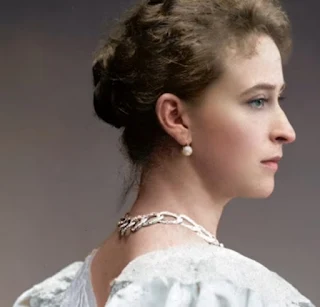Sister
Elisabeth, the Saint
She was born
Princess Elisabeth of Hesse and by Rhine in 1864 at Darmstadt, Germany. The
second daughter of Queen Victoria’s third child, Princess Alice and husband,
Grand Louis IV, Grand Duke of Hesse and by Rhine. She was nicknamed Ella.
Family
tragedies struct Princess Elisabeth's life. Two of her
siblings died young. A brother from hemophilia and a sister from diphtheria that had also killed their mother at the young age of 35.
Upon the death
of Princess Alice, the young princesses, Victoria (the future Marchioness of
Milford-Haven and the grandmother of Prince Philip), Ella and Alix (who would
become Empress Alexandra of Russia) were taken by Queen Victoria to live with
her in Windsor Castle.
Princess Elisabeth of Hesse and by Rhine
Ella was by
far one of the most beautiful royal princesses in Europe during her time. She
attracted many suitors including her first cousin, Emperor Wilhelm II of
Germany, but she chose to marry her true love, Grand Duke Sergei, the son of
Emperor Alexander II of Russia. Her younger sister, Alix, would marry Sergei’s
nephew, the future Tsar Nicholas II, in later years.
Elisabeth
became Grand Duchess Elisabeth Feodorovna after marriage and was deeply attached to
charitable works, helping to improve lives of displaced people in the Russian
society.
Grand Duchess Elisabeth and her husband, Grand Duke Sergei of Russia
In 1905, her
husband was assassinated, they had no children, so Elisabeth decided to
consecrate her life to religious and charitable works. She gave up her royal
possessions and entered the convent. She founded
the Charity of Martha and Mary in the Order of Mercy in Moscow, took her Holy
Vow and became a nun. She immersed herself feeding the poor.
In 1918, a day
after her sister, Empress Alexandra, brother-in-law Nicholas II and their
children and servants, were massacred by the Bolshevics in the mountain of
Ekaterinburg, she and other relatives of the emperor were arrested. They were
brought to the mountain of Alapeyevsk and were thrown into a mine shaft. As
their bodies were piled below, the Bolshevics threw a hand grenade.
Ella as Sister Elizabeth
Sister
Elisabeth was heard singing church hymns as piles of smoke from explosion rose
into the air. The assassins made sure they were dead by piling grass on top of
the shaft and lighted by fire. The royals died from suffocation.
When the advancing White Army arrived in Alapeyevsk, they took the remains of the victims and were buried to the Far East. Sister
Elisabeth’s body was brought to Jerusalem and buried at the Church of Mary Magdalene.
In 1981, the Russian Orthodox church
canonized her and the other murdered imperial family members and were
recognized as martyrs unfairly killed by the revolutionists.
Princess Alice
of Battenberg
She was born privilege, a princess and a scion to one of the most powerful royal families in
Europe. Her mother was Princess Victoria of Hesse and by Rhine, granddaughter
of Queen Victoria of England and sister of Princess Ella and Empress Alexandra,
her father was Prince Louis of Battenberg, first Sea Lord of England at the
outbreak of World War I.
Her parents
would soon suffer a humiliation during the war due to anti-German sentiments in
England. Prince Louis was forced to give up his post in the Royal Navy and his
princely title and was created by his cousin, King George V of England, as the
first Marquess of Milford-Haven. He also anglicized his name to Mountbatten.
Alice was the
older sister of George Mountbatten, Lord Louis Mountbatten and Louise, Queen Consort of Sweden.
In 1905, she married Prince Andrew of Greece and Denmark, son of King George I
of Greece and had five children: Princess Margarita, Princess Theodora,
Princess Cecille, Princess Sophia and Prince Philip, who would marry the future Queen of England, Elizabeth, in 1947.
Tragedy would
soon befall on her family which affected her mental health. In 1917, her brother-in-law, King Constantine I (whose wife, Princess
Sophia, was her first cousin through Queen Victoria) was forced to abdicate.
Alice and
Andrew, together with other Greek royal family members, were sent into exile but were permitted to return to Greece during
the reign of Constantine I’s son, George II. Prince Andrew also served as his
nephew’s military commander.
Prince Andrew and Princess Alice with their children
However, in
1922, Greece was defeated by Turkey, many generals were assassinated. Prince
Andrew was tried and found guilty of treason for abandoning his post under
enemy’s fire. He was condemned to die by firing squad.
But his status
as a royal prince allowed him to have a grace period before the execution will
be carried out. This gap of days gave Princess Alice an opportunity to seek
help from her cousin, King George V of England.
Princess Alice with her only son, Prince Philip
The English
king, still grieving the death of his first cousins, Emperor Nicholas II and
Empress Alexandra, and his failure to rescue them, determined never to repeat
the same mistake on another cousin.
He immediately
dispatched a British war ship to Greece to take Andrew and his family out of
the country. Prince Philip, who was only 18 months, was safely put on an orange
crate while the family was fleeing.
They settled
outside Paris and based on Prince Philip’s recollection, they had a happy
family life. However, after their daughters married German princes and settled
in Germany, cracks in marriage would soon take over that prompted Princess
Alice to suffer a nervous breakdown.
Prince Philip with his mother wearing a gray habit of a nun
Unable to
handle the humiliation of living under financial support of his rich royal relatives,
Prince Andrew left his wife and moved to Monaco and took a mistress. Princess
Alice suffered a nervous breakdown.
By 1930, she
became delusional and could no longer take care of her young son, Prince
Philip, so he was sent to England to live with his grandmother in Kensington
Palace.
Princess Alice
was put in a mental asylum and was subjected to barbaric experimental treatment
of Sigmud Freud, an Austrian neurologist who pioneered psychoanalysis. Princess
Alice was diagnosed of having Schizophrenia. She tried to escape from the
sanitarium many times but was unsuccessful. Until she was released in 1932.
For five years
nothing was heard from her. She lived a nomadic life in Germany. In 1937, one
of her daughters, Princess Cecil, was killed in a plane crash with her husband,
children and mother-in-law. Princess Alice attended the funeral and it was the
first time she saw her husband and children, including the 16 year old Prince
Philip.
By then, the
future Duke of Edinburgh has identified himself as thoroughly English despite
carrying the name Prince Philip of Greece and Denmark. He was by then raised by
her maternal uncle, Lord Mountbatten, and attended Gordounston College in
Scotland.
Following the
wedding of her only son to the future Queen Elizabeth II, Alice founded a
nursing order of the Greek Orthodox nuns, The Christian Sisterhood of Martha
and Mary, to feed the poor and help take care of the sick. She opened a charity
kitchen in Athens and used her influence to secure medical supplies.
She was known
to have help a Jewish family, the Cohen, to hide in her apartment when Nazi
occupied Greece.
In 1967 when
her nephew, King Constantine II, was deposed by the military junta and Greece
was once again plunged into chaos, her son, Prince Philip, took her to England
for safety. She lived with the royal family in Buckingham Palace.
Before her
death in 1969, Princess Alice told her son that she wished to be buried next to
her aunt, Sister Elisabeth, at the Church of Mary Magdalene in Jerusalem. This
was not followed because of political issues and she was buried in the royal
crypt at St. George’s Chapel in Windsor.
It was finally
granted in 1988 and her remains were transferred to Jerusalem. Princess Alice
was posthumously awarded with Righteous Gentile of all Nations in Israel due to
her courage to protect a Jewish family. The award was received by Prince
Philip.
He also
visited his mother’s grave in 1994 and Prince William in 2018. Despite her
status as royal, Princess Alice had no possessions when she died as she had
given everything to the charity. But she kept a diamond tiara, a wedding
present from her father-in-law, King George I. She gave it to her son in 1947
when he proposed marriage to the future Queen of England.
The tiara was
dismantled and made into an engagement ring and a meander tiara as Philip’s
gift to his bride.




















0 Comments